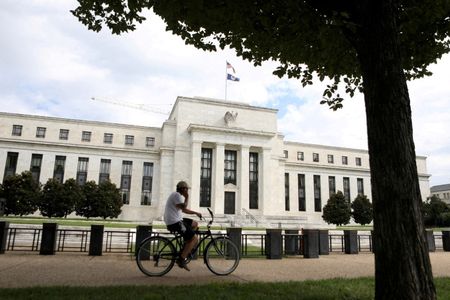By Yoruk Bahceli
(Reuters) -The European Central Bank said on Thursday it would start reducing its 5 trillion euros’ ($5.3 trillion) worth of bond holdings from March, in its next step towards tighter policy as it battles decades-high inflation.
It also raised its main interest rates by another 50 basis points each.
The central bank for the euro zone said it would trim its holdings of bonds bought under its Asset Purchase Programme (APP) at an average pace of 15 billion euros per month from March through June, with the subsequent pace to be determined over time.
It will do so by not reinvesting all the cash it receives from maturing bonds in a process called quantitative tightening, or QT. It will provide more detailed parameters at its February meeting.
“We believe that it is totally legitimate, appropriate and actually efficient to go in the direction of reducing the size of our balance sheet, to do that in a measured and predictable way,” ECB President Christine Lagarde told a news conference.
By raising longer-term borrowing costs, the reduction should tighten financial conditions, making it more expensive for firms and governments to borrow.
“The Governing Council will regularly reassess the pace of the APP portfolio reduction to ensure it remains consistent with the overall monetary policy strategy and stance, to preserve market functioning, and to maintain firm control over short-term money market condition,” the ECB said in a statement.
The process will complement its cycle of rate hikes, which target short-term funding costs. The ECB’s Thursday rate increase brings its total rise since July to 250 basis points – an unprecedented pace of tightening.
Lagarde said the 15 billion euro amount was chosen as it represents roughly half the cash the ECB would receive from maturing bonds over that period of time.
“It seemed an appropriate number in order to normalise our balance sheet, bearing in mind that the key tool is the interest rate,” she said.
The amount compares to a 175 billion euro reduction in bond holdings next year that analysts had expected, based on a Reuters poll.
“The fact that they already came with a decision to start QT first of March, that is the surprising part,” said Piet Christiansen, chief analyst at Danske Bank.
Many analysts had expected the ECB to outline abstract principles for QT rather than announcing such concrete plans.
“The fact that they came with a decision already now, that is I would say hawkish,” Christiansen added.
Under the APP, which it launched in 2015 to combat deflationary risks, the ECB has made 3.3 trillion euros of purchases, the bulk of its debt holdings. It has evolved into the leading creditor for many euro zone governments.
The ECB will continue to support debt markets, as the plan excludes the 1.7 trillion euros of debt it has bought through its more flexible Pandemic Emergency Purchase Programme (PEPP) since 2020. The ECB will continue replacing maturing PEPP debt until at least end-2024.
The bank will be chipping away at its bondholdings just as euro zone governments plan for increased borrowing next year to fund energy price support measures, meaning governments will have to lure more private investors to buy the debt, which is likely to come at a price.
Euro zone government bond yields rose sharply across the board after the ECB’s decision, as markets also raised their bets on where rates will peak.
Benchmark Italian bond yields jumped over 25 basis points in their biggest jump since March 2020, and the risk premium they pay over Germany jumped as high as 206 basis points, the most in a month.
The move to start quantitative tightening follows a similar step by the U.S. Federal Reserve earlier this year.
The ECB has already reduced its balance sheet by taking back 800 billion euros of ultra-cheap funding from banks, but at 8 trillion euros its total assets remain exceptionally large by historic standards.
($1 = 0.9407 euros)
(Reporting by Yoruk Bahceli; Editing by Catherine Evans and Hugh Lawson)














